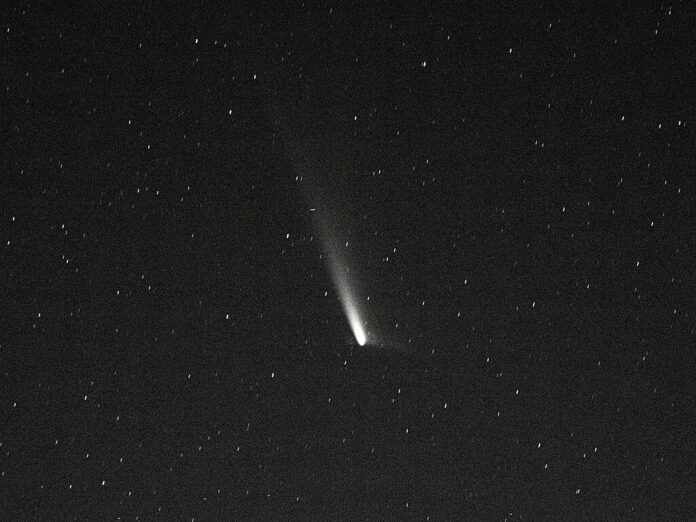Once expected to light up the night sky, Comet A3 could break apart before its close encounter with the sun, dimming hopes for a stunning celestial show this Halloween.
Comet A3, a massive celestial body that last passed by Earth 80,000 years ago, might not dazzle stargazers as previously predicted. Originally dubbed the “Halloween comet,” Comet A3—also known as Tsuchinshan-Atlas—was set to provide a rare and unforgettable sight as it blazed through the night sky in late October. However, new warnings from astronomers have cast doubt on the comet’s survival, with some experts fearing it could disintegrate before reaching the height of its visibility.
Spanning a staggering 30,000 miles in diameter and trailing a tail that stretches over 18 million miles, Comet A3 is a truly impressive spectacle. Its sheer size, with a nucleus larger than Mount Everest, has made it a topic of fascination among both professional astronomers and amateur stargazers alike. But, as with any celestial body nearing the sun, the comet faces immense pressure and heat. Scientists now suggest these forces may prove too much for the comet to withstand.
Embed from Getty ImagesLeading the concerns is Dr Qicheng Zhang, an astronomer at Lowell Observatory in Arizona, who recently spoke out about the comet’s precarious future. He cautioned that while Comet A3 was initially thought to be a bright and visible feature in the night sky, there’s a strong chance it will break apart before it can fully display its glow. “There’s just as good a chance it falls apart before its close encounter with the sun on October 28,” said Dr Zhang. “If that happens, virtually nothing will be visible afterwards in November.”
The fear of disintegration comes from observations made earlier this month, which revealed unusual activity around the comet. Scientists noted a sudden increase in gas vapour emanating from its surface, suggesting that parts of the comet might already be destabilising. This release of gas, combined with the tidal and rotational forces acting on the comet as it approaches the sun, could ultimately tear its nucleus apart. As it disintegrates, any fragments would likely be too dim to see without specialised equipment, putting an end to what could have been a breathtaking event for millions of people across the globe.
Despite the uncertainty surrounding the comet’s fate, astronomers had initially been excited by the possibility of a rare sighting. Comet A3’s long journey through space, spanning millennia, makes it an incredibly unique phenomenon. Most comets that pass close to Earth are on much shorter orbits, giving scientists regular opportunities to study their movements and makeup. A3, however, follows a much more distant route, with its last close encounter with Earth taking place during the Stone Age. The next time it returns, it’s likely humanity will have evolved in ways unimaginable today.
For those still holding out hope, the best chance to see Comet A3 will come just before its closest approach to the sun, expected on 28 October. Astronomers advise looking to the western sky after sunset, as the comet should be visible with the naked eye under optimal conditions—if it survives its close brush with the sun, that is. If Comet A3 remains intact, it will likely appear as a bright, orange-coloured streak, thanks to its rich composition of ancient ice and dust, giving it an eerie glow fitting for the Halloween season.
However, even the most seasoned stargazers are being urged to temper their expectations. As the comet gets closer to the sun, the heat and gravitational pull will intensify, putting more strain on its already fragile structure. If it doesn’t survive, the night sky will remain unchanged, leaving us with only the knowledge that we almost witnessed a truly extraordinary event.
This potential disintegration mirrors other notable comets that have met a similar fate in the past. Comet ISON, for example, was expected to put on a grand show in 2013 but ultimately broke apart as it neared the sun. Like A3, it was a much-anticipated astronomical event, but nature had other plans. Comets are, by their very nature, unpredictable—fragile remnants from the dawn of the solar system, prone to break apart when their icy cores face the full intensity of the sun’s rays.
The team at Lowell Observatory, along with other scientists around the world, will continue to monitor Comet A3’s progress in the coming weeks. The possibility of fragmentation is real, but so too is the chance that it will defy the odds and light up the sky as originally expected. If that happens, it would provide a rare treat for astronomy enthusiasts, offering a glimpse into a distant part of our solar system’s past.
For now, we wait. As October 28 approaches, the fate of Comet A3 hangs in the balance. Whether it will blaze across the night sky or vanish into cosmic dust remains to be seen. Either way, the “Halloween comet” has already given us plenty to wonder about, reminding us once again of the beauty and unpredictability of our universe.
